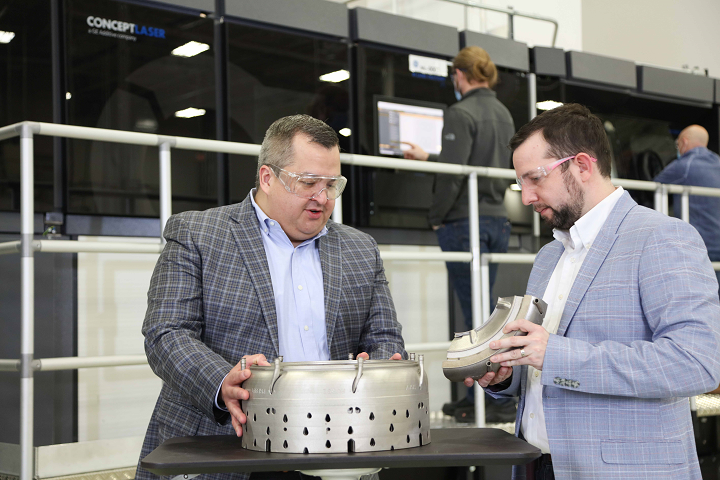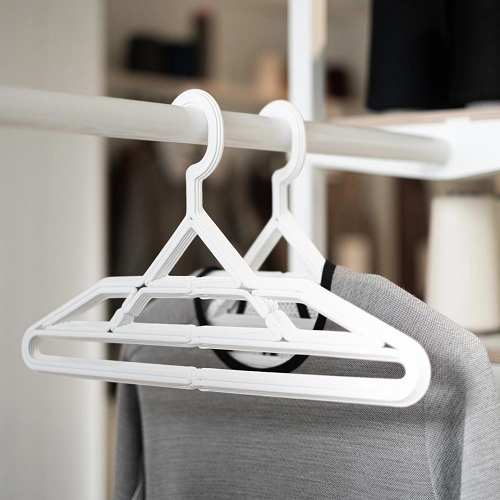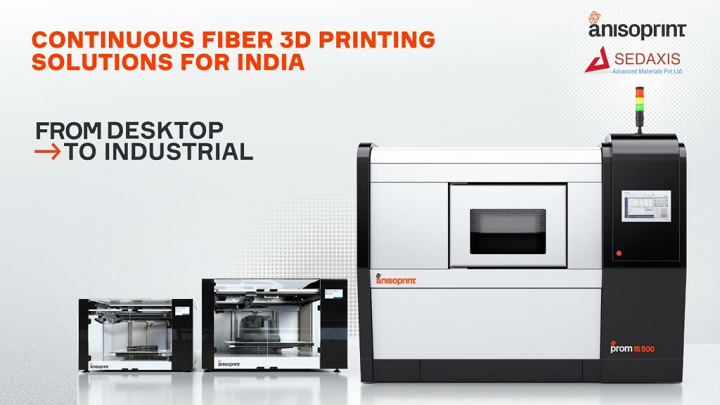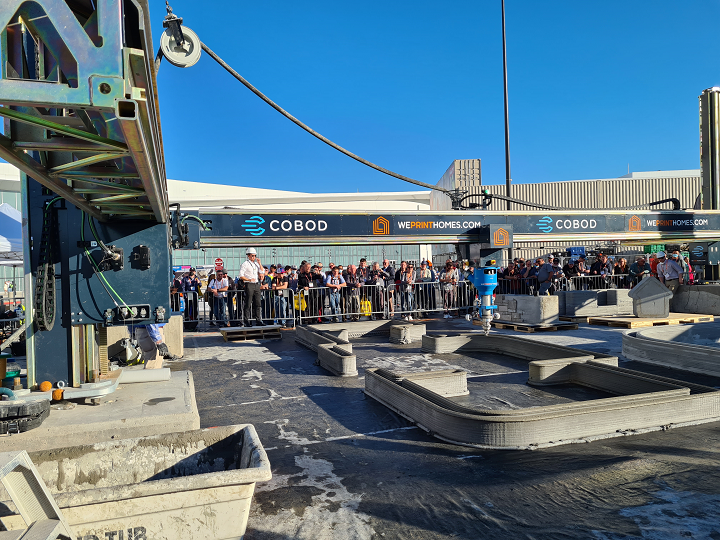We’ve got an interesting consumer goods application to tell you about in today’s 3D Printing News Briefs before we move on to business in India, an investment in metal 3D printing, and a bioprinting breakthrough. Finally, we’ll end with construction 3D printing.
Aectual and BYBORRE 3D Printing Circular Clothes Hangers
Aectual, which calls itself “the platform for circular customizable architecture products,” is back with another one: circular clothes hangers. Designed by textile platform BYBORRE and 3D printed by Aectual, the hangers were manufactured for the WoTO (Window of Textile Opportunities) space of BYBORRE’s founder and creative director Borre Akkersdijk. The unique hangers are plant-based and VOC-free, 100% circular, and can be purchased exclusively via Aectual in packs of four and five different color choices.
“I believe in an open eco-system, in always looking around you and being open to new encounters. In that case, that’s genuinely how we connected since we’re literally in the same street in Amsterdam,” Akkersdijk said about why he approached Aectual for the product. “Then we noticed that we share many of the same beliefs and a certain mindset together. It’s a kind of new Zeitgeist we’re in. We both think in processes and in sharing these: We don’t do things just for ourselves but believe in sharing with others via our platforms. And of course, a major thing that I liked is your circularity; Literally trillions of cloth hangers for instance are being thrown away in our (fashion) industry every year. So, it was a lovely thought to make a circular, fully recyclable cloth hanger together with our interior designers La Bolleur and you.”
Anisoprint and Sedaxis Partner to Grow Carbon Fiber AM in India
Moving on, carbon fiber 3D printer startup Anisoprint has exclusively partnered with Sedaxis Advanced Materials to expand carbon fiber 3D printing in India. The two signed a reseller agreement for the Indian market. Sedaxis, a service and distribution partner for emerging technologies, will distribute Anisoprint’s patented Continuous Fiber Co-Extrusion (CFC) 3D printing systems. The partnership will help carbon fiber 3D printing spread throughout India and give companies there access to excellent technology for producing composite end-use parts using the Anisoprinting technology.
“Until recently, the Indian ecosystem has had to endure a lack of options in continuous composite 3D printing systems. The introduction of Anisoprint’s fully open systems in India in 2019 has had an overwhelming response from some of India’s leading research institutions and universities. Industries too have been quick to notice the benefits of Anisoprint’s CFC systems – lower operational expenditure thanks to open materials and a first-of-its-kind composite lightweight functionality,” said Vishwanath Godavarty, the Business Head for 3D Printing at Sedaxis. “As Anisoprint’s exclusive partner in India, we look forward to supporting innovation in India’s manufacturing sector while taking this relationship to the next level.”
GE Aviation Acquiring Five M Line Metal 3D Printers

GE Additive M Line system installed at GE Aviation’s Additive Technology Center (ATC) in West Chester, OH. L-R: Benito Trevino, general manager – additive integrated product team, GE Aviation and Chris Philp, ATC site leader, GE Aviation. Image courtesy of GE Additive.
In metal AM news, GE Aviation announced that it is investing in five Concept Laser M Line metal AM production systems from GE Additive. Over the last three years of the M Line’s maturation phase, GE Additive and GE Aviation have worked together with other medical and aerospace customers to beta test the system, resulting in extra safety and software features and over 300 design improvements, including a 54% increase to the build envelope. This year, four of these printers will be installed at GE Aviation’s Additive Technology Center (ATC) in West Chester, Ohio, two of which will be dedicated to aluminum alloy; the third will be for cobalt chrome and the fourth for nickel alloy 718. In addition, a fifth M Line will be installed at Avio Aero’s Turin site in Italy to support the serial production of the GE Catalyst turboprop engine components.
“Our goal is to realize the aviation additive industry’s first automation ready production environment. Once installed, we envisage that our multi-machine approach, with the M Line platform at the heart of production, will help us reduce our lead and print times by over 50%,” said Benito Trevino, general manager – additive integrated product team at GE Aviation.
Biotech Startup Nuclera Raises Funds for Protein 3D Printer
Nuclera, a biotechnology startup, wants to 3D print proteins and just announced a €38m Series B round of funding that will help improve drug development and discovery using 3D printed proteins. Proteins are a structural part of all living organisms and essential to the biological processes of our cells. Still, it can take long to synthesize protein research for drug discovery purposes. Nuclera plans to use this funding to launch its desktop e-protein bioprinter, which it says can print proteins within 24 hours for the first time. Backers include Amadeus Capital Partners, M&G, RT Partners, Future Planet Capital, and E Ink.
“The key to making drug discovery accessible is making proteins accessible,” explained Michael Chen, Nuclera’s Co-Founder and CEO. “And so we want our customers to be able to have these bioprinters right at the benchtop to be able to make proteins and, ultimately, characterise proteins and discover drugs against these proteins on a single platform.”
Azure Factory Turns Old Plastic Products into Building Material
In terms of 3D printed homes, concrete is the most used material; plastic, recycled or otherwise, is often reserved for applications like furniture. But Azure Printed Homes says that its new 15,000-square-foot factory in California was developed to fabricate backyard studios and homes using repurposed plastic waste and a custom-made 3D printer. Azure wants to move towards a circular economy with its homes and accessory dwelling units, or ADUs, by using recycled materials rather than new ones. The company says that 3D printing allows it to build 70% faster, with 30% fewer costs, than using conventional construction methods, and is currently accepting pre-orders for its ADUs and studios.
“We have created production efficiencies not only by capitalizing on the advances in 3D printing but by creating a design and process that is completed in only 12 hours. When compared with conventional construction, we produce the entire structural skeleton, the exterior sheathing, the water control barrier, the exterior finish, the passageways for utilities, and the grounding for interior finishes, in a fraction of the time and cost,” said Azure Printed Homes Co-Founder Ross Maguire. “By revolutionizing a new age of home building with our sustainable, automated and exact production processes, we see a very, very exciting future ahead.”
COBOB 3D Printed Live Construction Applications at World of Concrete
Finally, COBOD International, along with materials provider QUIKRETE and 3D builder and developer We Print Homes, had the opportunity to 3D print building structures in front of live crowds for three days at this winter’s World of Concrete convention in Las Vegas, which welcomed about 37,000 attendees and 1,100 vendors. Since 2019, the company has sold more than 35 of its construction 3D printers on six continents, and these have been used to 3D print homes, schools, and even a wind turbine tower base. The company wanted to demonstrate its BOD2 printer live to highlight the technology’s market readiness and used its continuous 3D printing to build a wall structure in front of very large crowds at what was labeled a “must-see” exhibition., where visitors had the opportunity to ask questions as well.
“Our goal with 3D printing in front of a live audience at World of Concrete was to demonstrate the advantages of our technology in US as our main market, at the same time demonstrating that our technology is reliable and ready to be used in the US,” said Philip Lund-Nielsen, Co-Founder and Head of Americas at COBOD. “We wanted to show that 3D construction printing is not just a lab idea, but a viable and competitive alternative to traditional construction methods. The massive number of inquiries during and after show tells me that we succeeded with our goals.”
Subscribe to Our Email Newsletter
Stay up-to-date on all the latest news from the 3D printing industry and receive information and offers from third party vendors.
You May Also Like
Gorilla Sports GE’s First 3D Printed Titanium Cast
How do you help a gorilla with a broken arm? Sounds like the start of a bad joke a zookeeper might tell, but it’s an actual dilemma recently faced by...
Nylon 3D Printed Parts Made More Functional with Coatings & Colors
Parts 3D printed from polyamide (PA, Nylon) 12 using powder bed fusion (PBF) are a mainstay in the additive manufacturing (AM) industry. While post-finishing processes have improved the porosity of...
$25M to Back Sintavia’s Largest Expansion of Metal 3D Printing Capacity Since 2019
Sintavia, the digital manufacturing company specializing in mission-critical parts for strategic sectors, announced a $25 million investment to increase its production capacity, the largest expansion to its operations since 2019....
Velo3D Initiates Public Offering in a Bid to Strengthen Financial Foundations and Drive Future Growth
Velo3D (NYSE: VLD) has been among a number of publicly traded 3D printing firms that have attempted to weather the current macroeconomic climate. After posting a challenging financial report for 2023,...




































